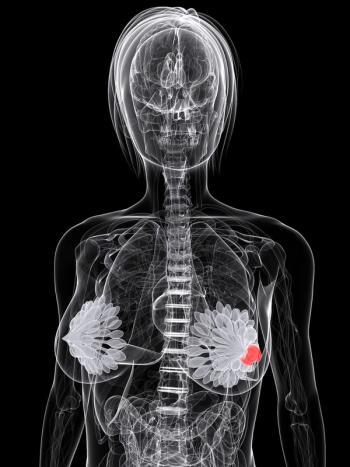
Analyzing Natural Killer Cell Restoration/KIM-1 Biomarker in Kidney Cancer
A genitourinary oncologist explained that KIM-1 can be used to diagnose, risk-stratify, and detect disease and monitor disease treatment in patients with kidney cancers.
In an interview with CancerNetwork®, Vincent Xu, MD, medical oncologist at Dana-Farber Cancer Institute and an assistant professor of medicine at Harvard Medical School, discussed key insights into the clinical landscape for kidney cancers following 2 presentations he gave at the
Initially, Xu highlighted the rationale for conducting the phase 0 study, expressing that it was initiated to assess whether cytokine-based treatment for anticancer cells would restore their immunity. He further suggested that these cells would be advantageous in that they could offer activity after current standards for kidney cancer treatment, such as immune checkpoint inhibition, do not. Xu hoped that efficacy shown in this early-stage trial would help lead to the development of chimeric antigen receptor (CAR) T-cell and NK-based therapies as well as treatments that are generally more active, safe, and accessible.
He also described KIM-1, a protein typically overexpressed in kidney cancer cells that could be detected in the bloodstream. Xu suggested that the biomarker could be used as a noninvasive means of detecting, diagnosing, and risk-stratifying disease and monitoring disease treatment for kidney cancers. He explained that most research into KIM-1 was retrospective but expressed that more data could help inform more personalized kidney cancer treatments.
CancerNetwork: What was the rationale for assessing these memory-like natural killer cells in patients with RCC or urothelial carcinoma as part of this phase 0 pilot study?
Xu: What we know from preclinical research is that NK cells are supposed to kill cancer cells. That’s part of their job in the body. Clearly, in patients who have metastatic kidney cancer or urothelial bladder cancer, these cells are somehow not doing their job. We went to ask the question, “Why are these cells not doing their job?” We found that the NK cells that infiltrate kidney tumors are increasingly dysfunctional as the tumor grows and are being suppressed in their anticancer immunity. This trial is asking the question of whether we can restore the function of these anticancer cells by collecting them from patients and treating them with cytokines, hopefully as a new anticancer treatment.
What advantages might these memory-like killer cells offer compared with other therapeutic strategies in RCC?
Xu: This is one of many possible ways that we could treat RCC. The advantage of these cells is that they are different from the currently approved immune checkpoint inhibitors and the currently approved VEGF TKI [tyrosine kinase inhibitor]. These are treatments that might have activity after presenting standard therapies have failed. Compared with other emerging cell therapies, such as CAR T cells, NK cells are in some ways less toxic. There’s less cytokine release syndrome, and the cells don’t have to rely on MHC-I [major histocompatibility complex class I], so they may be able to bypass some of the resistance mechanisms with other immunotherapies.
Considering everything that you described in your presentation, what do you hope others take away from your presentation on this phase 0 study?
Xu: It’s an early-stage study, a pilot first-in-human [study]. From this study, we’re hoping to get some science, study how these cells work, to see if they have function, and to figure out if the approach is feasible and safe. The hope is that we’ll see some activity in this early-stage trial, which will let us develop further CAR T and even CAR NK strategies, with the hopes that what we learn from this trial will help us make the therapy safer, more efficacious, and more broadly available.
What is the background of your presentation on advancing KIM-1 as a tool for kidney cancer?
Xu: KIM-1, which is also called kidney injury molecule 1, also called TIM-1, is a protein that’s overexpressed in kidney cancer cells. The protein is at high levels on the surface of kidney cancer. There’s a section of the protein, the extracellular domain, which is cleaved off into the blood and is detectable. It’s a blood biomarker that you can detect in the blood. The benefit of KIM-1 [is] it’s a noninvasive way to detect kidney cancer. What we found through several studies across disease stages in kidney cancer is that you can use KIM-1 to diagnose, risk-stratify, detect, and monitor disease treatment.
Specifically, in patients who are [in] early stage with a renal mass, [high levels of] KIM-1 in the blood can predict a more aggressive [and higher-risk] tumor. In patients who have undergone surgery and had their tumors removed, if the KIM-1 levels remain high, that patient is more likely to recur and benefits more from adjuvant immunotherapy. In [patients in the] metastatic [setting], higher levels of KIM-1 predict more aggressive disease and worse overall prognosis. Patients who have an improvement in KIM-1 after 3 weeks of immunotherapy, so 1 dose of treatment…those patients do well long term.
What might current data show regarding the potential role that KIM-1 may play in the use of immunotherapy and other strategies for kidney cancer?
Xu: We’ve been analyzing KIM-1 retrospectively from clinical trials where hundreds of patients had their data and samples collected. In the future, what I’m hoping we will see is that as we have more data on KIM-1, we can use this to make treatment decisions. What we’re currently working on are clinical trials that will let us measure KIM-1 and then use that information in real time to decide what the best next treatment step is for the patient, moving one step closer to personalized treatment of kidney cancer.
What should others take away from this presentation focused on the use of KIM-1?
Xu: What I'm hoping is that the wonderful patients and the kidney cancer community that we have at this meeting can come together and work together to move these biomarkers into prospective trials. At the end of the day, the only way we’re going to help patients is if we work together with patients to be able to answer these questions prospectively and to show that this makes patients better.
References
- Xu W. A phase 0 pilot study of memorylike natural killer (NK) cell immune therapy in patients with renal cell carcinoma or urothelial carcinoma (NCT06318871). Presented at: 2025 Kidney Cancer Research Summit; July 17-18, 2025; Boston, MA.
- Memory-like natural killer (NK) cell therapy in patients with renal cell carcinoma or urothelial carcinoma. ClinicalTrials.gov. Updated June 11, 2025. Accessed July 22, 2025. https://tinyurl.com/44scjkfe
- Xu W. From bench to bedside: advancing KIM-1 as a tool for clinical decision-making. Presented at: 2025 Kidney Cancer Research Summit; July 17-18, 2025; Boston, MA.
Newsletter
Stay up to date on recent advances in the multidisciplinary approach to cancer.

















































































